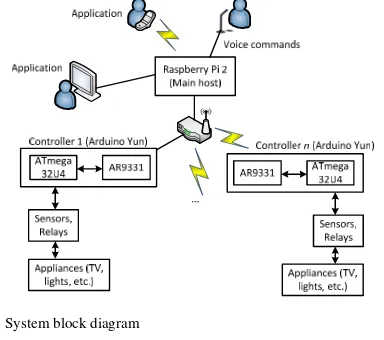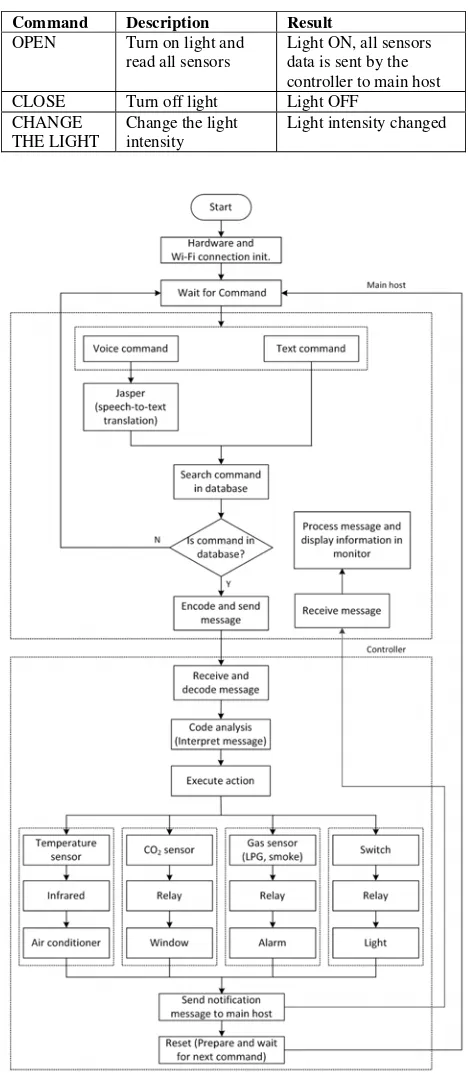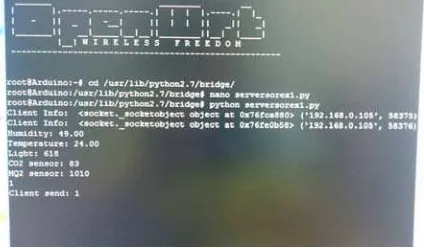IoT-based Control Application for Smart Home
Chui-Yuan Liu#, Theophilus Wellem*, Chih-Chun Peng#, Ming-Yan Chen#, Yu-Kuen Lai#
#Department of Electrical Engineering, *Department of Electronic Engineering Chung Yuan Christian University, Zhongli, Taiwan, 32023
{g10478005, g10202604, g10478024, g10478025, ylai}@cycu.edu.tw
Abstract— This paper present an ongoing work on the design of an IoT-based control application for smart home. The system prototype is comprised of single-board computers as the main host and one or more controller boards. The main host can receive voice commands from user via a microphone, and instruct the controller boards to control home appliances. Sensors are also attached to the controller boards to allow intelligent control of home appliances according to user requirements. The main objective of this system is to help the elderly and people with visual impairment to easily control home appliances via a voice user interface.
Keywords
—
Internet-of-Things; Jasper; Raspberry Pi 2; smart home; Arduino Yun;I. INTRODUCTION
Internet-of-Things (IoT) is a novel network communication paradigm which extends the current Internet to incorporate objects (things) such as sensors, RFID, actuators, and vehicles in everyday life. Objects become “smart” because they are capable of communicating, sharing information, and executing actions [1]. Recently, IoT concept has been applied to develop smart cities [2], healthcare and ambient assisted living. It also includes smart home automation systems that can support elderly people in their daily life [3, 4]. These systems utilize communication technologies to automatically control home appliances and devices such as, televisions, refrigerators, air conditioners, washing machines, lights, rice cooker, and microwave oven. Wireless sensor networks (WSN) based on ZigBee or Bluetooth is typically used to connect and gather data from sensor devices. Ethernet and mobile cellular networks are utilized to connect the home network to Internet [4, 5].
According to World Health Organization (WHO) data in August 2014, 285 million people are estimated to be visually impaired worldwide with 39 million are blind and 246 have low vision. About 90% of the world's visually impaired live in low-income settings. 82% of people living with blindness are aged 50 and above [6]. Elderly and people with visual impairment are commonly having difficulties in their daily life. To better improve their living convenience, IoT applications such as, health monitoring system, fall detection system, and control system at home can be utilized.
In this paper, we design a control system using Jasper IoT platform running on a single-board computer (Raspberry Pi 2) and Arduino Yún microcontroller board that can help elderly and visually impaired people to control home appliances, such as lights, television, and air conditioner. The system provides smart phone, PC-based interface and voice interface for the
user. Compared to computer and smart phone applications, voice user interface is preferable for elderly people, because it allows them to interact with the system easily. The rest of this paper is organized as follows. Section II outlines several related works on IoT for smart home and healthcare. Section III describes the system design and implementation. Section IV presents the evaluation of the system, and Section V concludes the paper.
II. RELATED WORK
Several works have utilized IoT in smart home and healthcare. In [4], Jie et al. developed a smart home system which incorporated IoT technologies. Their smart home system utilized RFID. Each home appliance was equipped with an RFID tag. Using the tag, a particular home appliance can be identified and controlled by a centralized controller connected to home network. Bing etal. [5] also proposed an IoT-based smart home system. Different from [4], the smart home system utilized ZigBee and 3G networks. Wang etal. [7] proposed a smart control system for smart home. It utilized a central controller, sensors and actuators, which construct a wireless sensor and actuator network (WSAN) at 433 MHz frequency. Relays, sensors, actuators are connected to the central controller, and the central controller is connected to Internet via a wireless router. In [8], a voice recognition on home automation control system is developed. The system comprised of a Raspberry Pi, a microphone, a speaker, a USB sound card, and an 8-channel relay module (connected directly to the Raspberry Pi GPIO). Its voice command application uses the Application Programming Interface (API) from Wolfram Alpha. Wolfram Alpha API converts the recorded sound into text to be processed by Raspberry Pi.
III.SYSTEM DESIGN
The system block diagram is shown in Fig. 1. It comprised of two parts: 1) a single-board computer (SBC) which acts as the main host/terminal and provides interface to user (connection to microphone), and 2) one or more microcontroller boards which receive the command from the main host/terminal, execute the commands, and communicate with the sensors and actuators (relays) to control the home appliances.
Fig. 1 System block diagram
TABLEI
SINGLE-BOARD COMPUTER CONSIDERED IN THIS WORK
Board Processor RAM Release
Year
Banana Pi ARM Cortex-A7
1 GHz Dual core CPU
DDR3 1GB
2015/8 50
LinkItOne ARM7 EJ-S
260 MHz
There are several choices for the single-board computer and microcontroller boards available in the market as listed in Table I. Raspberry Pi 2 [10] is the second generation of Raspberry Pi board developed by Raspberry Pi Foundation. Raspberry Pi 2 Model B board is equipped by a Broadcom
BCM2836 System-on-Chip (SoC) with quad-core ARM Cortex-A7 processor.
Arduino Yún [11] is an open-source electronics platform designed for IoT projects. The board is based on an 8-bit AVR microcontroller ATmega32U4 and Atheros AR9331, which is a system-on-chip (SoC) for WiFi access point and router platform. The Atheros AR9331 SoC includes a MIPS 24K processor and supports IEEE 802.3 Fast Ethernet and 802.11n for wireless network. The MIPS processor runs a Linux distribution based on OpenWrt, called Linino. The communication between AR9331 and ATmega32U4 is using serial port and handled by a bridge library.
Raspberry Pi 2 board and Arduino Yún were chosen in this work since they are widely used and supported by the community. Furthermore, the features supported by these boards are suitable to the requirement of this system. It is also can be obtained at affordable price.
Users can control home appliances using application on their computer/smartphone or using voice commands from the microphone. Commands to the system are spoken in English. A voice command received by the Raspberry Pi 2 board is then converted to a specific message, and sent to the Arduino Yún board to control the appliances. Python socket programming is used to write the software for communication between Raspberry Pi 2 board and Arduino Yún board. According to the message received, the microcontroller (in the Arduino Yún board) can switch on/off the TV, lights, or other appliances, change TV channels, reads data from sensors and executes a particular action. In addition to use wire connection, the communication links between controller board and sensors/actuators also can be done wirelessly by using the built-in WiFi module in the Arduino Yún, additional Zigbee and Bluetooth modules. WiFi has an advantage that it can reach longer distance compared to Zigbee or Bluetooth. The system usage scenario is depicted in Fig. 2.
A. Hardware
1) Main Host and Voice Recognition Software: Jasper [12] is used and installed on the Raspberry Pi for main host. The voice recognition relies on the PocketSphinx speech-to-text engine. Controller modules, shown in Fig. 2, are developed based on Arduino Yún board. These boards are connected to the Raspberry Pi board via wired or wireless connection.
2) Controller, Relays, and Sensors: Relays are used to switch lights on or off. Infrared emitters (IR LEDs) are utilized as the remote for air conditioner and TV. In addition, four sensors are used in this system: temperature sensor, light sensor (include LDR), CO2 sensor, and MQ-2 sensor (for smoke and LPG leakage detection). The temperature sensor works together with an infrared emitter to control the air conditioner. For example, when the room temperature is not in accordance with user predefined setting, the sensor will send a notification to the infrared emitter to adjust the air conditioner settings. The CO2 and MQ-2 sensors work with relays to open the window if the room’s CO2 level is increasing, or switch on the alarm if there is a certain level of smoke/LPG leakage. Light sensor is used to measure the light intensity inside a room. These relays, IR LEDs and sensors are connected to the GPIO port of the controller board.
B. Software
The system flowchart is shown in Fig. 3. The system works as follows. It starts with the hardware initialization and preparing the WiFi connection. After the initialization process, the system is ready to receive commands. Two programs has been developed, one for the Raspberry Pi (Jasper’s voice-controlled module) and the other one for the Arduino Yún.
IV.RESULT AND DISCUSSION
We conducted the testing of our system by using voice commands, and observed the system's response. During the experiments, we kept track of the speech recognition errors and other errors encountered. The speech recognition accuracy, translation of voice to message, and correctness of message communication between the main host and controllers are verified. For control functions, switching the lights and TV can be executed successfully without long delay. Fig. 4 shows the terminal on the main host (Raspberry Pi) side when an “OPEN” command is received. The main host will send a code to the controller to read all sensors status and switch on the light. As shown in Fig. 5, the terminal on controller (Arduino Yún) side receives a code number “1”. To turn off the light, user can use “CLOSE” command. Other commands supported are “TEMPERATURE” and “CHANGE THE LIGHT”. Table II shows the testing results.
TABLEII
TESTING RESULTS
Command Description Result
OPEN Turn on light and
read all sensors
Light ON, all sensors data is sent by the controller to main host
CLOSE Turn off light Light OFF
CHANGE THE LIGHT
Change the light intensity
Light intensity changed
Fig. 4 Raspberry Pi (main host) terminal when receive “OPEN” command from the user.
Fig. 5 Arduino Yun (controller) terminal when receive code “1” from the main host.
V. CONCLUSION AND FUTURE WORK
This work presents an IoT-based voice control system implementation designed to assist visually impaired and elderly people at home to accomplish control tasks. Comparison of several single-board computers and microcontroller boards is also presented. Raspberry Pi 2 and Arduino were chosen for the system herein. The experiment results showed that the system was able to work properly. Currently, we are trying to optimize the tasks and improve the system performance on the speech recognition process. Factors such as, user speaking speed, volume, and accent play
major influence of successful speech recognition rate. For future work, we plan to develop smarter control mechanisms based on sensor readings for more appliances and deploy the system for real-world testing for visually impaired and elderly people.
REFERENCES
[1] Al-Fuqaha, A., Guizani, M., Mohammadi, M., Aledhari, M., and Ayyash, M., “Internet of Things: A Survey on Enabling Technologies, Protocols and Applications,” IEEE Communications Surveys Tutorials. 2015.
[2] Zanella, A., Bui, N., Castellani, A., Vangelista, L., and Zorzi, M., “Internet of Things for Smart Cities,” IEEE Internet of Things Journal, vol. 1(1), pp. 22–32, 2014.
[3] Dohr, A., Modre-Opsrian, R., Drobics, M., Hayn, D., and Schreier, G., “The Internet of Things for Ambient Assisted Living”, in Seventh International Conference on Information Technology, pp. 804–809, 2010.
[4] Y. Jie, J. Y. Pei, L. Jun, G. Yun, and X. Wei, “Smart Home System Based on IOT Technologies,” in 2013 Fifth International Conference on Computational and Information Sciences (ICCIS), 2013, pp. 1789– 1791.
[5] K. Bing, L. Fu, Y. Zhuo, and L. Yanlei, “Design of an Internet of Things-based smart home system,” in 2011 2nd International Conference on Intelligent Control and Information Processing (ICICIP), 2011, vol. 2, pp. 921–924.
[6] World Health Organization Media Center, “Visual impairment and blindness”, http://www.who.int/mediacentre/factsheets/fs282/en/
[Online]. Accessed: November 5, 2015.
[7] M. Wang, G. Zhang, C. Zhang, J. Zhang, and C. Li, “An IoT-based appliance control system for smart homes,” in 2013 Fourth International Conference on Intelligent Control and Information Processing (ICICIP), 2013, pp. 744–747.
[8] S. Hidayat and S. F. Firmanda, “Scheduler and voice recognition on home automation control system,” in 2015 3rd International Conference on Information and Communication Technology (ICoICT), 2015, pp. 150–155.
[9] Freescale Home Heath Hub Reference Platform,
http://freescale.com/homehealthhub. [Online]. Accessed: November 5, 2015.
[10] Raspberry Pi, https://www.raspberrypi.org/ [Online]. Accessed: November 5, 2015.
[11] Arduino Yun, https://www.arduino.cc/en/Main/ArduinoBoardYun
[Online]. Accessed: November 5, 2015.


